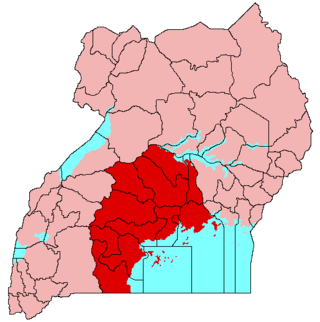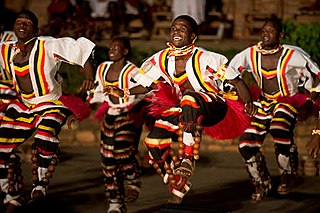
The Adhola people, also known as Jopadhola, are a Nilotic ethnic group of Luo peoples that live in Tororo District of Eastern Uganda and comprise about eight percent of the country's total population. They speak Dhopadhola,, which belongs to the Western Nilotic branch of the Nilotic language family. They are primarily pastoralists. The Jopadhola call their land Padhola which, according to historian Bethwell Ogot, is an elliptic form of "Pa Adhola" meaning the "place of Adhola", the founding father of the Jopadhola people. Officially, land of the Adhola is called Padhola, but the Baganda who misinterpret 'Widoma' – a Dhopadhola word for 'war cry' meaning 'You are in trouble' refer to the Jopadhola as "Badama". The social structure of the Jopadhola can be described as semi centralised because there is no traditional centralized government and its organization is limited to a clan called Nono. There are over 52 clans, each with cultural practices, common ancestry and a distinct lineage.

Buganda is a Bantu kingdom within Uganda. The kingdom of the Baganda people, Buganda is the largest of the traditional kingdoms in present-day East Africa, consisting of Uganda's Central Region, including the Ugandan capital Kampala. The 14 million Baganda make up the largest Ugandan region, representing approximately 16% of Uganda's population.

The Lango are a Nilotic ethnic group. They live in north-central Uganda, in a region that covers the area formerly known as the Lango District until 1974, when it was split into the districts of Apac and Lira, and subsequently into several additional districts. The current Lango Region now includes the districts of Amolatar, Alebtong, Apac, Dokolo, Kole, Lira, Oyam, Otuke, and Kwania. The total population of Lango District is currently about 2,884,000.
The early history of Uganda comprises the history of Uganda before the territory that is today Uganda was made into a British protectorate at the end of the 19th century. Prior to this, the region was divided between several closely related kingdoms.

The Protectorate of Uganda was a protectorate of the British Empire from 1894 to 1962. In 1893 the Imperial British East Africa Company transferred its administration rights of territory consisting mainly of the Kingdom of Buganda to the British government.

The Tooro Kingdom is a Bantu kingdom located within the borders of Uganda. The current Omukama of Tooro is King Oyo Nyimba Kabamba Iguru Rukidi IV. King Oyo Nyimba Kabamba Iguru Rukidi IV took to the throne of Tooro kingdom in 1995 at the age of just three years, after the death of his father Omukama Patrick David Matthew Kaboyo Rwamuhokya Olimi III on August 26, 1995, at the age of 50.

In Uganda the most spoken language in the capital city is Luganda, followed by English, as all schools in Uganda use it in their studies due to the introduction of English during the colonial period. English is also the language of business and judicial matters. Most spoken after Luganda and English is Swahili. This language is more common in neighbouring Kenya and Tanzania. Swahili is taught in schools as an optional additional language and it is mostly spoken by the Ugandan army. In 2005, there were talks to include Swahili as the second official language as it was seen as neutral, however this is still not ratified by the government. Swahili is used among some communities bordering South Sudan and Kenya.

The Karamojong or Karimojong are a Nilotic ethnic group. They are agro-pastoral herders living mainly in the north-east of Uganda. Their language is also known as ngaKarimojong and is part of the Nilotic language family. Their population is estimated at 475,000 people.

The Nyoro people, also known as Banyoro are a Bantu ethnic group native to the kingdom of Bunyoro in Uganda. They live in settlements on a well-watered and fertile plateau. Banyoro are closely related to other Bantu peoples of the region, namely the Batooro, Banyankole, Bakiga and the Bahema peoples.

The Uganda Museum is located in Kampala, Uganda. It displays and exhibits ethnological, natural-historical and traditional life collections of Uganda's cultural heritage. It was founded in 1908, after Governor George Wilson called for "all articles of interest" on Uganda to be procured. Among the collections in the Uganda Museum are playable musical instruments, hunting equipment, weaponry, archaeology and entomology.
Buruuli (place) is a general term used to refer to the area where the Baruuli live. It is located in the district of Nakasongola, as well as in Bugerere Kayunga District. The Baruuli speak the Ruruuli language, a Bantu language closely related to Lunyala, a language spoken by the Banyala of Kayunga District. The Baruuli are ruled and governed by Ssabaluuli Mwogezi, who was crowned as their Isabaruuli by the president of Uganda Yoweri Kaguta Museveni.

The Jie are an ethnic group in Uganda. They belong to the Karamojong Cluster, which also includes the Karamojong and Dodoth people. Their country in northeast Uganda lies between the Dodoth to the north and the Karamojong to the south.

The Tooro people, also known as Batooro or Toro people are a Bantu ethnic group, native to the Tooro Kingdom, a subnational constitutional monarchy within Uganda.

The Acholi people are a Nilotic ethnic group of Luo peoples, found in Magwi County in South Sudan and Northern Uganda, including the districts of Agago, Amuru, Gulu, Kitgum, Nwoya, Lamwo, Pader and Omoro District. The Acholi were estimated to number 2.3 million people and over 45,000 more were living in South Sudan in 2000.

Entogoro, also known as Orunyege, is a traditional courtship dance that is performed by the Batooro people of western Uganda. The dance holds great significance in the Tooro culture, practiced by young adults to select potential partners for marriage, as well as during weddings, initiation ceremonies, and social gatherings. Its name comes from the ebinyege rattles and entogoro rings associated with the dance.
Ugandan folklore includes traditional folktales and other folklore from the African country of Uganda. The convey meaning and experiences from generation to generation. Traditionally, folktales instilled discipline and good behaviour that shaped societal beliefs and norms within Ugandan society.

Bakisimba dance (Baakisiimba) also known as Nankasa or Muwogola is a traditional dance form originating from the Baganda people of Buganda Kingdom in Central Uganda. It is believed to have originated from the movements of a drunken King Ssuuna of Buganda Kingdom. The dance was initially performed in the Buganda Royal Court in ancient times an it holds significant cultural and social importance within the community and is often performed during tribal ceremonies, celebrations, and festive occasions.

So (Tepeth) are a tribe living in the mountain ranges of mountain Moroto in the northeast part of Uganda and North western Kenya in the Turkana region. Traditionally, the So (Tepeth) were hunters and fruit gatherers, the decline in wild animals in the region made them resort to agriculture for sustainable living between 1970 and 1980. Tepeth are believed as original occupants of Karamoja plains unfortunately the current settlers (Karamojong people) pushed the Tepeth up on the mountain.

Calabash is a traditional plant locally grown in many parts of Uganda. Its a non-food plant that produces several fruits of different sizes. The biological name of this plant is Lagenaria siceraria. Once harvested, its left to dry and is mainly used for traditional purpurses like dancing during traditional weddings, crafted as musical instruments by some tribes in their traditional dances for example the Bigwala, Baganda, Acholi, preserving milk, harvesting milk cream, and also used by traditional healers. Calabash is a symbolic cultural item that many Ugandan tribes use for different purposes.



















